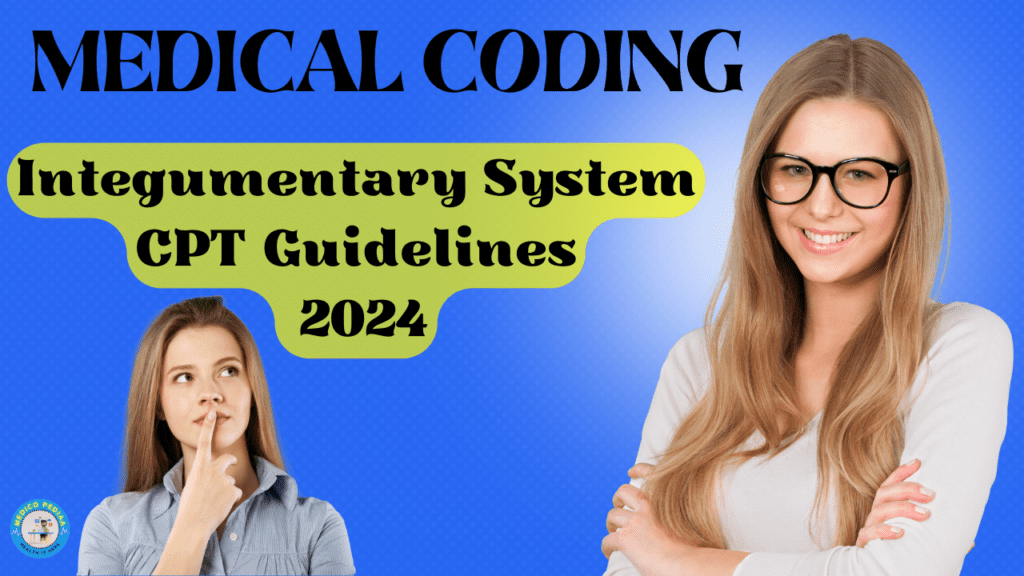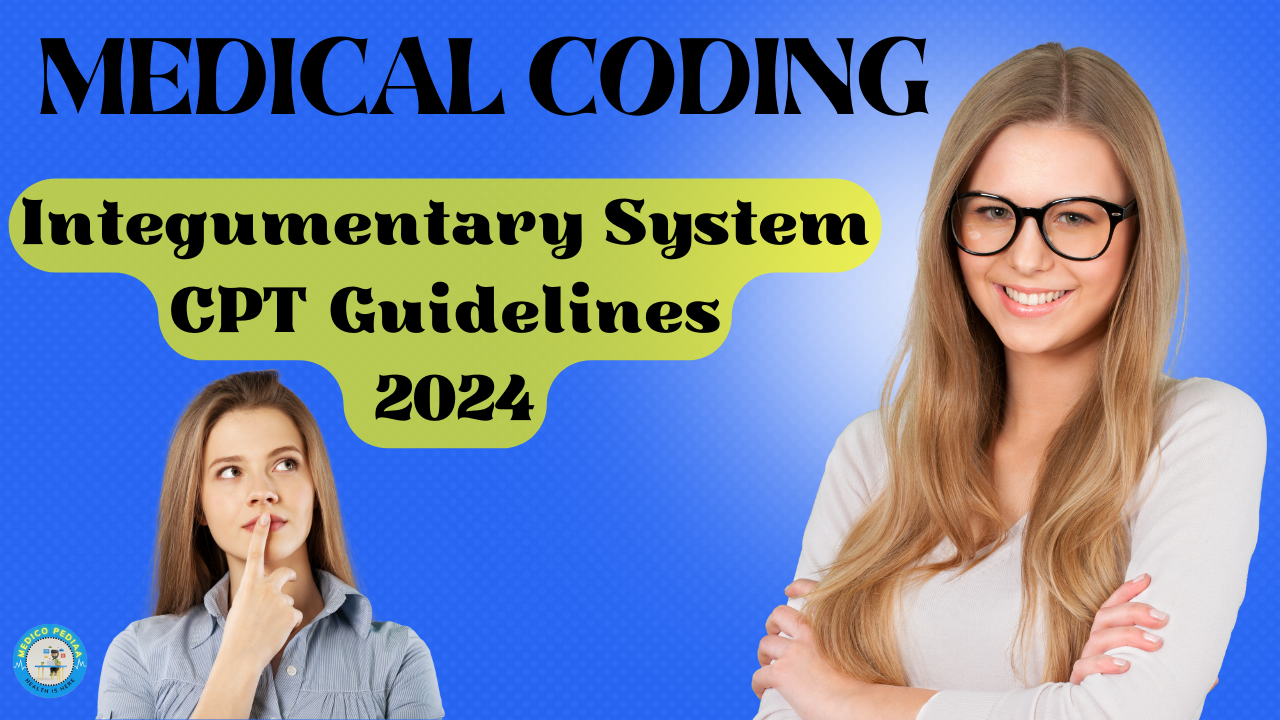Integumentary System CPT Guidelines 2024
Integumentary System : –
Hello Reader , Today we Explain about Integumentary System CPT Guidelines 2024 . In this article we cover all guidelines related to integumentary system cpt in very easy way , and also explain all main important code range of integumentary system cpt guidelines .
The integumentary system is the largest organ of the body that forms a physical barrier between the external environment and the internal environment that it serves to protect and maintain.CPT Codes 10030–1999 include surgical procedures on the integumentary system. The American Medical Association maintains a medical code set called Current Procedural Terminology (CPT) code range 10030-19499 for Surgical Procedures on the Integumentary System.

FINE NEEDLE ASPIRATION (10021–10012) :-
A Fine needle aspiration (FNA) biopsy is performed when material is aspirated with a fine needle and the cells are examined cytologically.
Guidelines of Fine needle aspiration :
- FNA do not required location.
- Each lesion one code every lesion different code.
- Do not capture imaging guidance included.
- If we apply more than one primary code then apply 59 modifier.
- In FNA, same guidance same lesion don’t code guidance code.
- FNA and Core needle biopsy same lesion or different lesion, different guidance apply 59 modifier on guidance code.
CORE NEEDLE ASPIRATION:-
A Core needle biopsy is typically performed with a larger bore needle to obtain a core sample of tissue for histopathologic evaluation.
INCISION AND DRAINAGE INTEGUMENATARY SYSTEM CPT(10040- 10180)
-
Incision means cut and drainage means put out something.
-
Incision and drainage minor surgical procedure to release pus or pressure built up under the skin, such as from an abscess , cellulitis.
-
If the physician makes an incision but no drainage performed, the procedure should be reported with a 52 modifier (reduced services).
Two types of incision and drainage :-
1.Incision and drainage (simple):
Incision and drainage performed without packaging material cotton, dry gauze.
2. Incision and drainage (complicated):
Incision and drainage performed with the help of packaging material that time we have to consider its multiple type of incision and drainage.
-
Multiple incision
-
Drain placement
-
Break up locations
-
Extensive packing
-
Subsequent wound closure
DEBRIDEMENT(11000-11047 ) :-
Removal of dead tissue until the viable tissue repair.
Types of Debridement :-
-
Excisional Debridement(11042-11047): excisional Debridement is the sharp removing tissue at the wound margin or at the wound base until viable tissue is removed.
-
Selective Debridement 97597-97598): selective Debridement is the removal of nonviable tissue unlike excision debridement, the physician remove no living tissue in a selective debridement.
-
Non selective Debridement (97602): Non selective debridement is the gradual removal of nonviable tissue and is generally not performed by a physician.
Guidelines for Debridement :-
-
Body site where the necrotized soft tissue is located.
-
Look up for % of skin infected.
-
Open fracture based on depth layers.
-
Body square based on depth and square cm.
-
Do not combine sums from different depth.
-
But combine sum for same depth.
-
Same wound with different depth then report only deep wound.
-
Different wound with same depth then add surface area of wound with same depth.
-
Different wound with different depth then report each wound depth with 59 modifier.
BIOPSY(11102-11107) :-
Sample of tissue taken for test to determine presence or extent of disease.
Methods of biopsy :-
There are three methods of Biopsy
-
Incisional biopsy(11106-11107)
-
Punch biopsy(1104-11105)
-
Tangential biopsy(11102-11103
Incisional Biopsy(11106-11107)
-
done using sharp blade .
-
To remove full thickness sample of tissue; penetrate deep to dermis into subcutaneous space.
-
Simple closure is included in the service.
Punch biopsy(11104-11105)
-
performed using punch tool.
-
To obtain cylindrical tissue sample for diagnostic pathological examination.
-
Simple repair included in this service.
Tangential biopsy:(11102-11103)
- performed with sharp blade.
- To remove superficial sample of epidermal tissue without portion of underlying dermis.
Guidelines of Biopsy :-
-
Biopsy followed by definitive procedures like excision, shaving and debridement code only definitive procedures.
-
Code only biopsy if it is without definitive procedure.
-
When two different sites are involved; on left side of any body part biopsy was performed followed by definitive procedure on right side ; Then code for both definitive procedure.
-
On the basis of hierarchy first code incisional primary code then puch addition code and tangential biopsy addition code.
REMOVAL OF SKIN TAGS (11200- 11201) :-
Common skin growth in which a short narrow stalk stick out.
Guideline of skin tags-
-
If more than 15 lesions, use add on code.
SHAVING OF EPIDERMAL AND DERMAL LESIONS (11300-11313)
Shaving means slicing or peeling of epidermal or dermal layer without disturbing subcutaneous tissue.
Guidelines of epidermal and dermal lesions :
-
Look for body site.
-
Body group.
-
Code each lesion separately.
-
Don’t add the diameter on the same site or different anatomical site same body group.
EXCISION :-
Excision simply means “to cut“ either cancerous or noncancerous tumors. Surrounding of tumors are removed which is healthy tissue is known as margin.
Types of Excision :-
-
Benign lesion (11400-11471): Excision (including simple closure) of benign lesion of skin (e.g neoplasm, clcatrical, fibrous, cystic, inflammatory and congenital lesions) include local anesthesia.
-
Malignant lesion (11600-11646): Excision (including simple closure) of malignant lesion of skin (e.g badal cell carcinoma, squamous cell carcinoma, melanoma) includes local anesthesia.
CPT Guidelines for Excision: –
-
Look for body site.
-
Body group.
-
Which types of lesion benign or malignant.
-
Lesion diameter.
-
Code each lesion separately.
-
Don’t add the diameter on the same site or different site of same body group.
-
Consider highest diameter and lowest margin ( always double the margin).
-
Includes simple repair, code intermediate and complex repair separately with excision.
-
Excision + simple repair = code only excision.
-
Excision + intermediate repair = code both.
-
Excision + comolex repair = code both
-
Biopsy + excision = code both.
-
Excision + surgical grafting = code for both.
-
Excision+ ATT = code only ATT (adjacent tissue transfer).
REPAIR :-
- Patient having some wound in order to cure that physician will do some procedure that is laceration repair.
- A laceration is a wound that occurs when skin , tissue and/ or muscule is torn or cut open.
- Laceration repair is closer of wound using stirrstips (do not code in repair), glue , suture and staples.
Types of repair :-
-
Simple repair
-
Intermediate repair
-
Complex repair
Simple Repair (12001- 12021):-
The physician closes a superficial layer of the wound or simple single -layer closure using tissue adhesive(dermabond), staples or sutures materials.
Intermediate repair(12031-12057):-
It requires layered closure of two layers with suture material.
Single layer closure of heavily contaminated wounds that have required extensive cleaning or removal of particulate matter (foreign body) also constitutes intermediate repair.
Complex repair(13100-13160):-
It requires closure of multiple layers with scar revision or debridement, extensive, undermining.
The physician debrides the wound by removing foreign material or damaged tissue.
Guidelines for Repair :-
-
Types of repair.
-
Length of laceration.
-
Anatomical location.
-
Hierarchy of repair first code complex repair then intermediate repair and then simple repair.
ATT(Adjacent tissue transfer) :-(14000-14302)
Guidelines of ATT:-
-
If you term is Z plasty, W plasty, V-Y plasty, rotational flap, random island flap, and advancement flap then you have to code ATT code.
-
In ATT (Adjacent tissue transfer) bundle excision, repair.
-
Traumatic wound closed in Z,Y,W plasty then don’t code ATT code.
SURGICAL PREPARATION (15001-15005) :-
The initial services related to preparing a clean and viable wound surface for placement of an autograft flap, skin substitute graft or for negative pressure therapy.
Guidelines of surgical preparation :-
-
Key words are generally prepared, creation of site.
-
Anatomical site
-
Anatomical body group.
-
Add the diameter on the same anatomical site or different site of body group.
GRAFTING (SKIN REPLACEMENT SURGERY) (15040-15278) :-
Grafting refers to a surgical procedure to move tissue from one site to another one the body or from another creature without bringing its own blood supply with it. Instead a new blood supply grows in after it is placed.
Types of graft :-
-
Autograft
-
Allograft
-
Xenograft
Autograft types :-
-
Epidermis
-
Dermis
-
Epidemis+part of dermis= split thickness Graft.
-
Epidemis+ full dermis= full thickness Graft.
Guidelines of Graft :-
-
Identify type of graft.
-
Anatomical site.
-
Anatomical grop.
-
Add the diameter the same anatomical site or different site of body group.
BURN, LOCAL TREATMENT(16000-16036) :-
-
A type of injury to skin or tissue caused by heat, cold, electricity, chemistry friction or radiation.
-
Most burns are due to fires, heat from hot liquid and solid .
Guidelines of Burn :-
-
Codes are based on small, medium and large which indicates % of burn.
-
Small – less than 5 %
-
Medium – 5 to 10 %
-
Large – over 10 %
Destruction(17000-17286) :-
Synonyms: lysis, ablation
The process of damaging or destroying tumors or lesions by different type of techniques
Such as cryo, chemo, laser or electrical surgery.
Guidelines of Destruction :-
Identify type of lesions – benign, premalignant, or malignant lesion .
Identify type of techniques: cryo, chemo, laser or electrical surgery.
Benign or premalignant lesions are not based on anatomical site,but based on number of lesions.
51 modifier will never be coded along with add-on-code.
Sequence first malignant lesion followed by benign and premalignant.
Malignant lesion are based on anatomical sites to which body group it belongs.
- diameter
- Code each lesion separately
- Do not add the diameter.
MOHS MICROGRAPHIC SURGERY (17311-17315) :-
Mohs surgery is a multistaged method of excising a multistaged layer by layer along with histopathologic examination through microscope.
To ensure negative malignancy of the margins.
procedure used to treat certain types of skin cancer, penile cancer, mouth cancer (especially cancer of the lip), and soft tissue sarcoma of the skin.
Guidelines of Mohs Micrographic surgery :-
- Identify body group to which anatomical site it belong to.
- Identify stages every stage includes five tissue block, if more than 5 tissue block assign code for each tissue block.
- Code repair or graft if it is performed with Mohs Micrographic surgery.
- Do not surgical pathology code with Mohs Micrographic surgery.
FOR SERIES WISE CPT GUIDELINES :https://medicopediaa.com/category/cpt-guidlines/
Breast (19000-19499) :-
Guidelines of breast :-
-
Identify excision or biopsy.
-
In biopsy procedure physician may performe in three ways
-
With imaging and without imaging guidance.
-
Closed procedure.
-
Open procedure.
-
Code for each lesion separately.
-
3. Append modifier 59 for subsequent or addition lesion.
Some important Guidelines for integumentary system :-
-
We can use E&M code with surgery code with 57or 25 modifier.
-
Most important use of 51 and 59 modifier in integumentary chapter.
-
Modifier 51: we will use whenever two procedure are there like excision and repair (both has to be present in scenario).
-
Modifier 59: we will use whenever single procedure is going on like only repair is there in scenario.
-
If the physician makes an incision and no drainage that should be reported procedure with 52 modifiers (reduce service).
For Medical Coding : https://medicopediaa.com/list-of-modifiers-used-in-cpt/
CPT Guidlines Anesthsia : https://medicopediaa.com/anesthesia-cpt-guidelines/
In this Article We Cover important guidelines of cpt 1 series integumentary system .
Integumentary System CPT Guidelines 2024
For Any Query : DM me on Instagram – @medico_pediaa
